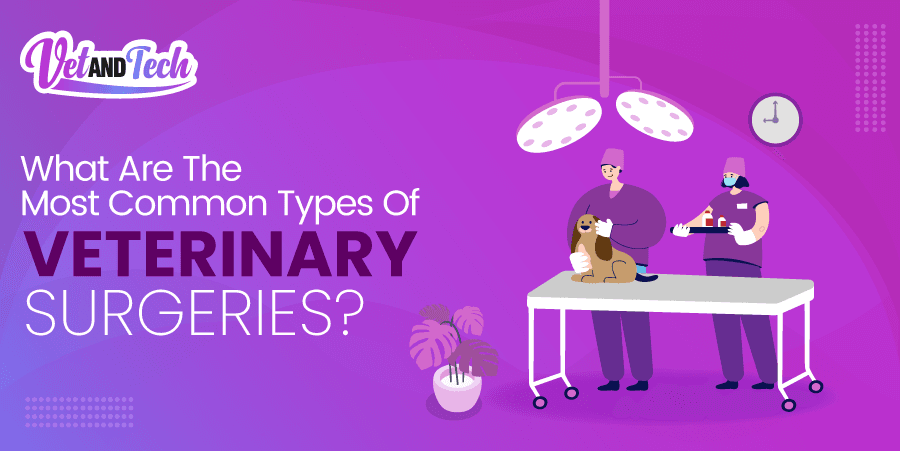What Are The Most Common Types Of Veterinary Surgeries?
Our pets often need animal surgeries, but we are unaware of the common procedures they might require. Surgeons have to perform a variety of veterinary surgeries on animals to treat their medical conditions. However, veterinary surgery will only be performed if the veterinarian believes it is clinically necessary for the animal patient.
In addition, pet owners' consent is necessary for the surgery. So no surgery is performed without your knowledge. But how can an owner make the decision about surgery? To make an informed decision about their pets, the owners must understand the various surgical procedures and their needs.
We'll review some of the most common surgeries, so you know what to expect if your pet needs surgery. This blog will go over various types of animal surgeries and the importance of surgery.
A Guide To Common Animal Surgical Procedures
Most pets will need veterinary surgery at some point in their lives. Your pet, for example, may require surgery to treat a condition or to be neutered or spayed. In addition, most animal operations are now relatively safe with advances in modern medicine and vast improvements in veterinary care standards. As a result, it is preferable to have your pet undergo surgery than to consider the risks associated with it.
Veterinary surgeries are divided into categories depending on the site and type of procedures. Continue reading to learn more about common veterinary surgical procedures. The major categories are all explained below.
Soft Tissue Surgery
Soft tissue surgery encompasses a wide range of procedures that involve internal organs, the body wall, masses or tumors, and hernias or defects. In other words, these procedures cover anything unrelated to bones, joints, muscles, or the nervous system. Spaying and tumor removal are the most common soft tissue surgeries.
Many animals develop masses and tumors just beneath the skin and internally at times. While not all of these lumps are cancerous, it is usually recommended that they be surgically removed. In some cases, these can include conditions like Soft Tissue Sarcoma in Dogs, which may require prompt surgical intervention. On the other hand, spaying or neutering your pet has many health and behavioral advantages. In addition, it can help prevent many chronic health problems and diseases of the reproductive system. Visit our page to read more about soft tissue surgery.
Ear Surgery
External and middle ear infections are common in dogs and cats. Ear disease frequently goes unnoticed by the owner until it has advanced, become well-established, and caused irreversible structural changes. For various reasons, initial medical management through medication may also fail. So the ear surgery for pets often becomes inevitable.
In addition, diseases of the external ear canal and middle ear are frequently associated with more than one underlying issue. Due to all these complications, ear surgery is commonly required if an animal develops any sort of ear issue. Canal resection, ear tumor removal, and osteotomy are common veterinary ear surgeries. Read more about these procedures on our ear surgery page.
Eye Surgery
Eye infections and diseases in pets are common problems caused by an allergy or a genetic condition. Red or inflamed eyes, swollen skin around the eye area, scratching their eyes, pus or excessive tears leaking from the eye, and cloudiness are all signs that your pet needs its eyes examined by a vet. While many eye conditions can be treated medically, others necessitate surgical intervention.
Eye surgery necessitates early detection and treatment in animals. Eye surgery, cataract surgery, entropion surgery, ectropion surgery, eyelid tumor removal, cherry eye surgery, and orbit exenteration are some of the most common veterinary ocular procedures. On our eye surgery page, you can read more about these procedures.
Oral Surgery
There are many reasons why a pet may require oral surgery. For pets, oral surgery may be required to remove growths, repair oral or dental defects, or repair a jaw fracture. Oral surgical procedures are required in some pets to remove plaque and calculus from tooth roots or extract unsalvageable teeth.
Oral procedures can sometimes be avoided with good dental and oral hygiene. However, accidental or congenital defects cannot be avoided. Hence, jaw fractures caused by trauma or disease frequently necessitate oral surgery to free the pet of pain. In addition, there is no known cause for some oral tumors. If oral tumors are discovered early on, surgical removal may be an option that results in a cure. You can read more about animal oral surgery on our page.
Orthopedic Surgery
Orthopedic surgery treats common musculoskeletal disorders in pets, including joint diseases, cruciate disease management (TTA, TPLO), and bone and joint fractures. Orthopedic issues are generally distinguished by the cause of the disorder and the affected body part.
Certain breeds and sizes of animals are more likely to be born with or develop orthopedic conditions such as hip displacement, knee injuries, and ACL tears. Orthopedic surgical procedures for animals are versatile, but some are more common than others. Arthroscopy, TPLO, Tibial Tuberosity, and other orthopedic surgeries are common. You can learn more about these orthopedic procedures on our website. You can learn more about these procedures in the Veterinary Orthopedic Exam for General Practitioners, presented in the second webinar by Clara S.S. Goh.
Neurological Surgery
Neurologic surgery is a surgical procedure that involves the brain and spinal cord. Some neurological conditions necessitate surgical intervention. Any damage to a pet's nervous system can have serious long-term consequences if not treated promptly by trained professionals.
The neurologist provides the advanced care and attention required to treat or manage a pet's neurological condition properly. Common veterinary neurosurgeries include intervertebral disc surgery, spinal fracture repair, lumbosacral surgery, canine cervical arthroplasty (artificial disc), and surgical brain and spinal tumor removal.
Minimal Invasive Surgery
Minimally invasive surgeries are advanced surgical techniques. These procedures cause less pain, cause less tissue trauma, and result in faster recovery than traditional methods. Our surgeons can access your pet's internal body cavities and organs without making large surgical incisions with minimally invasive surgeries.
These procedures employ tiny cameras and surgical instruments inserted through small incisions to locate organs, cut tissue, and ligate vessels. This technology allows surgeons to replace large surgical incisions with a few millimeter-long ones. As a result, many procedures, including liver biopsy, spays, cryptorchid castration, abdominal exploration and intestinal biopsy, gastrointestinal foreign body removal, and others, can be performed with minimal invasion.
Preparing your pet for surgery
There is no need to be alarmed if your veterinarian suggests that your pets undergo surgery. Because of significant advancements, most surgeries today are low-risk, so usually, there is no cause for concern. You simply must adhere to all pre-and post-surgical instructions.
Furthermore, it is critical to understand any potential complications associated with the operational procedure. To avoid complications, make sure to discuss the following issues with your veterinarian before surgery:
• Overall health and age of your pet
• Surgery-related complications
• Possible consequences if surgery is not performed
• After-surgery recovery and post-operative care at home
How can foreknowledge of surgery help your pet?
Pet owners must have knowledge of the various surgical procedures performed on their animals. For example, one must stay current on the regular procedures that their pets require, such as spaying, neutering, etc. Look into the common surgical procedures in cats, dogs, or other pets you own.
This knowledge will be helpful in a variety of situations, including:
• Knowing what to look for in your pet will help you recognize the signs.
• Early detection of issues frequently results in less pain and a faster recovery.
• You can prepare your pet in advance for the surgery.
• You can provide better pre-and post-operative care with complete knowledge of surgery.
• When you have a detailed understanding, you'll know what to expect after the surgery.
• The thorough knowledge will help you tackle pets, such as handling the side effects of anesthesia.
• You can recover your pet faster if you provide better post-surgical care according to their surgery.
• You will better understand why the surgery is necessary and how it will help your pet.
Wrapping Up
You should be aware of the common surgical procedures for pets by now. Pet owners should be knowledgeable enough to discuss their options with their veterinarians. Even though surgery has come a long way, minor procedures require careful planning. So, navigate to our surgical procedure page to read detailed information about various veterinary surgeries.
Vet and Tech surgical procedure encompasses a wide range of veterinary operations. In addition, most procedures include information about various aspects of surgery, such as symptoms, prevention, treatment, and cost. You can read this detailed information about the surgeries before your pet's procedure to gain a better understanding.
Frequently Asked Questions
What are the fundamental veterinary surgeries?
Spaying, neutering, dental extractions, and removal of benign skin growths are the most common elective pet surgery procedures.
Why are animals tested before undergoing surgery?
Pets are tested to adjust the amount and type of anesthesia used based on your pet's health and the procedure. Before surgery, blood tests ensure that the liver and kidneys can handle the anesthetic and may reveal any previously undetected organ dysfunction.
Why are animals starved before undergoing surgery?
Your pet will be starved before the general anesthetic to reduce the possibility of unconscious regurgitation (or vomiting). Fasting is usually 6-8 hours, but this will be discussed with you before your appointment.








